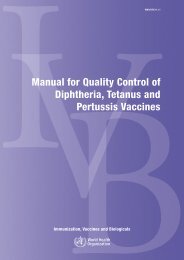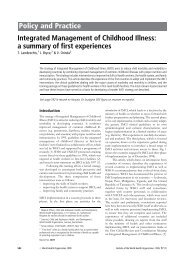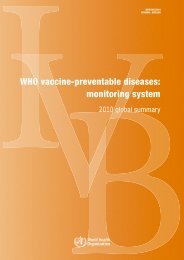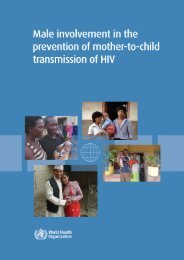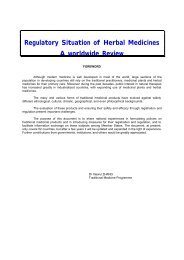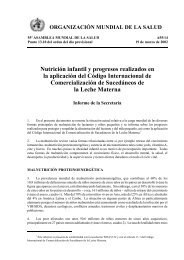IPDE - Extranet Systems - World Health Organization
IPDE - Extranet Systems - World Health Organization
IPDE - Extranet Systems - World Health Organization
You also want an ePaper? Increase the reach of your titles
YUMPU automatically turns print PDFs into web optimized ePapers that Google loves.
Discussion and conclusions<br />
Armand W. manger<br />
This investigation represents the first attempt to assess personality disorders<br />
(PDs) worldwide with contemporary methods of diagnosis. The<br />
semistructured inmiew (International Personality Disorder<br />
Examination-<strong>IPDE</strong>), developed within the <strong>World</strong> <strong>Health</strong> <strong>Organization</strong><br />
(WHO) program on diagnosis and classification, was designed to assess<br />
PDs within the framework and guidelines of two distinct but overlapping<br />
classification systems. DSM-111-R, which was intended for use in the<br />
US, is primarily the product of American psychiatric opinion, while<br />
ICD-10, which is meant for worldwide use, reflects the views and needs<br />
of the international psychiahic community.<br />
lnterrater Agreement<br />
To provide a valid diagnosis an inseument must first demonstrate a reasonable<br />
degree of interrater reliability. An international test of reliability<br />
such as the present one involves patients fmm a wide variety of national<br />
and cultural settings, who speak many different languages. The examiners<br />
also consist of a large number of psychiatrists and clinical psychole<br />
gists Wained at many different facilities amund the world. Therefore, this<br />
was an unusually exacting test of reliability to which no other interview<br />
for PDs has ever been subjected. The results, nevertheless, compare quite<br />
favourably with published reports on semistructured interviews that are<br />
used to diagnose the psychoses, mood, anxiety. and substance use disorders.<br />
Such comparisons, of c ow, must be viewed as rough approximations.<br />
There are obvious differences in the heterogeneity of the patient<br />
samples. the base rates of the individual disorders. as weU as variations in<br />
the methods used to measure reliability. Furthermore, many of these studies<br />
have been conducted within one facility only, and rarely have they<br />
been undertaken outside the nation in which the interview was developed.<br />
With these caveats in mind, we compared the results of the present<br />
study with those of the SCID Axis I field trial.' That study involved 390




